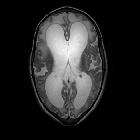Hurler disease

Preschooler
with a genetic syndrome. CXR AP (left) shows widened ribs which are narrowed at the costovertebral junction (oar-shaped). Lateral radiograph of the spine (right) shows anterior beaking of the inferior aspect of the L3 vertebral body.The diagnosis was Mucopolysaccharidoses Type I / Hurler syndrome.

Hurler
syndrome • Hurler syndrome - Ganzer Fall bei Radiopaedia

Hurler
syndrome • Mucopolysaccharidosis type I (Hurler syndrome) - Ganzer Fall bei Radiopaedia

Hurler
syndrome • Cerebral manifestations of mucopolysaccharidosis type I - Ganzer Fall bei Radiopaedia
Hurler syndrome is one of the mucopolysaccharidoses (MPS type I).
Epidemiology
The estimated incidence is ~1:100,000.
Clinical presentation
It manifests in the first years of life with intellectual disability, corneal clouding, deafness, and cardiac disease. Death usually occurs within the first decade of life, often from cardiac disease.
Pathology
Genetics
It carries an autosomal recessive inheritance.
Radiographic features
- macrocephaly
- prominent perivascular spaces
- cerebral atrophy
- diffuse white matter changes
- hydrocephalus
- pachymeningiopathy
- J-shaped sella
- concave articular surface of the mandibular condyle
- cord compression at the craniovertebral junction:
- C1-C2 subluxation: atlantoaxial subluxation
- narrowing of the foramen magnum due to a combination of short C1 arch, dysplastic odontoid, and thickened meninges and ligaments
- shortening and widening of long bones
- pointing of proximal metacarpals
- widening of anterior ribs (oar-shaped / paddle ribs) and clavicles
- thoracolumbar kyphosis or hypoplastic vertebra at thoracolumbar junction results in gibbus
- anterior inferior vertebral body beaking
- heart involvement
- cardiac valve disease: early-onset severe regurgitation and stenosis
- coronary artery disease
- cardiomegaly: initially hypertrophic then dilated
Other features include
- prominent perivascular spaces
- hepatosplenomegaly
History and etymology
It is named after Gertrud Hurler (1889-1965), a German pediatrician .
Siehe auch:
- Makrozephalie
- Mukopolysaccharidose
- Gibbus
- atlantoaxiale Subluxation
- Mukopolysaccharidose Typ I-S
- Mukopolysaccharidose Typ II
- J-förmige Sella turcica
und weiter:

 Assoziationen und Differentialdiagnosen zu Mukopolysaccharidose Typ I-H:
Assoziationen und Differentialdiagnosen zu Mukopolysaccharidose Typ I-H:





